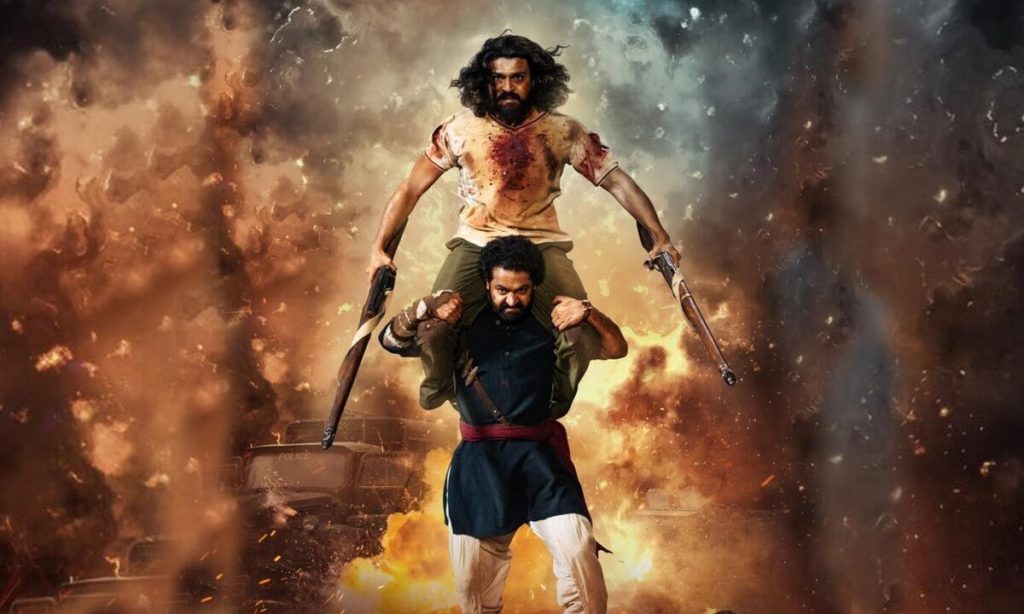RRR takes place in a semi-fictional past. Directed by S. S. Rajamouli, its imaginative take on India’s pre-independence period justifies the far-fetched feats and narrative twists and turns. The breadth of creative liberties taken allows RRR to develop its themes of unity, fraternity, and resilience in the face of oppression through an almost mythological lens. RRR tests the viewers’ ability and willingness to suspend their disbelief and pushes the bounds of melodramatic cinematic expression without straying from the tenets of the hero’s journey, as the recognizable checkpoints are ultimately met during the course of the plot. It is a movie of crises both moral and mortal, oozing with CGI, and thoroughly enjoyable.
After an extended intro that includes not one but two disclaimers, interspersed with titles supplying context for the film’s pair of protagonists, the story begins with a group of sadistic British imperialists abducting a child, Malli, from a native tribe. The person elected to protect their tribe (when he isn’t corralling feral wolves and jungle tigers), Bheem (N. T. Rama Rao Jr.) vouches to return the girl safely. Bheem’s arc is instantly set on a crash course with that of Raju (Ram Charan), an Indian working for the British Imperialist army who wants nothing more than to achieve the rank of “Special Officer”. He’s given the chance when the British magistrate offers a bounty for the man they are warned is coming to collect Malli and return her to her tribe. Raju searches for a man about whom he knows nothing, going undercover to squeeze information from the locals in the Delhi streets. He and Bheem are brought together, each unaware of the other’s true identity, during the first of many life-or-death situations. They are co-heroes, and, suddenly, fate having tugged its marionette strings, best friends. They proceed along their individual arcs in tandem, Bheem searching for Malli, and Raju searching for the mysterious outsider who he eventually discovers has been right under his nose.

The film takes its time deploying the totality of the protagonists’ motives and backgrounds. Raju’s character is more fully realized, given a much more complicated set of prerogatives that involve military training as a child, witnessing his father’s death before a circling battalion of British soldiers, and a certain dying wish promise. He possesses the most engaging arc. But, even as new information is leaked piecemeal to the viewer, the entirety of the film has a distinct feeling of predictability. There are the steps of Bheem and Raju’s individual, as well as collective, hero’s journey. The rise, fall, and redemption. Bheem becomes infatuated with a British lady of high social standing who suffers from a white savior complex. After a falling out in which Raju makes his loyalty to the Crown violently explicit, there is a glorious reunion in which two men literally become one to defeat their oppressors. The highs are high and the lows are low. The progression of this epic makes you wonder less about what is going to happen next, and more about how it is going to happen.
For while RRR adheres to a tried-and-true story structure and attendant plot conventions—not to mention the melodramatic exhibitions of emotion where it’s impossible to misunderstand a character’s implicit stance, subtlety having exited the film’s vocabulary within its opening minutes—the dynamism of its storytelling and the way it modulates the familiar narrative checkpoints keep the viewer engaged. The film is bold enough to nest flashbacks within flashbacks, quests within quests. The godlike feats of strength and brutal battle scenes solidify this grand tale as a mythology of morals that has little concern for the viewer’s ability to believe what they are seeing.
The film pushes the boundaries of cinematic expression, daring the viewer to say “that’s enough”—perhaps when an entire truck of wild tigers is unleashed at a military garden party, or when Raju and Bheem create a two-man superhuman and parkour their way out of a British prison. RRR is a story of the principles that have the power to guide an entire people—a vision of strength, resilience, and honor that appear larger than life under oppressive rule—told through the extravagance of a fable placed in a version of the past. Its predictability shouldn’t distract from the enjoyment that the pure cinematic imagination behind the camera elicits. It is the very same originality of thought that created the mythologies that have offered strength and direction to generations of viewers willing to believe.

Comments